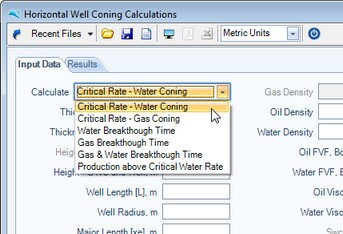|

  
|
||
The use of horizontal well technology in developing hydrocarbon reservoirs have been widely applied during the 1990's, and subsequent years.
The advantages of using a horizontal well over a conventional vertical well are their larger capacity to produce oil for the same drawdown, together with a longer breakthrough time at a given production rate.
Several horizontal well critical rate correlations are available in the literature, most of which are included within these routines. The method of Kuo and Desbrisay has been used within this routine, for horizontal wells, to predict the performance after water breakthrough.
The list of routines available are :
| • | critical rate calculations for gas and water coning, |
| • | breakthrough time calculation for both gas and water, and |
| • | production performance above critical rate for water. |
Accessing these routines is via a dropdown list box located towards the top of the application, as shown below.

References:
Chaperon, I., “Theoretical Study of Coning Toward Horizontal and Vertical Wells in Anisotrophic Formations: Subcritical and Critical Rates,” SPE Paper 15377, 1986.
Efros, D. A., “Study of Multiphase Flows in Porous Media”, Gastoptexizdat, Leningrad, 1963.
Karcher, B., Giger, F., and Combe, J., “Some Practical Formulas to Predict Horizontal Well Behavior,” SPE Paper 15430, 1986
Joshi, S., "Horizontal Well Technology", Pennwell, 1991.
Ozkan, E., and Raghavan, R., “Performance of Horizontal Wells Subject to Bottom Water Drive,” SPE Paper 18545, 1988.
Papatzacos, P., Herring, T. U., Martinsen, R., and Skjaeveland, S. M., “Cone Breakthrough Time for Horizontal Wells,” SPE Paper 19822, 1989.
Kuo, C. T., and Desbrisay, C. L., "A Simplified Method for Water Coning Predictions", SPE Paper 12067, 1983
Page url: http://www.YOURSERVER.com/help/index.html?definingschedule.htm